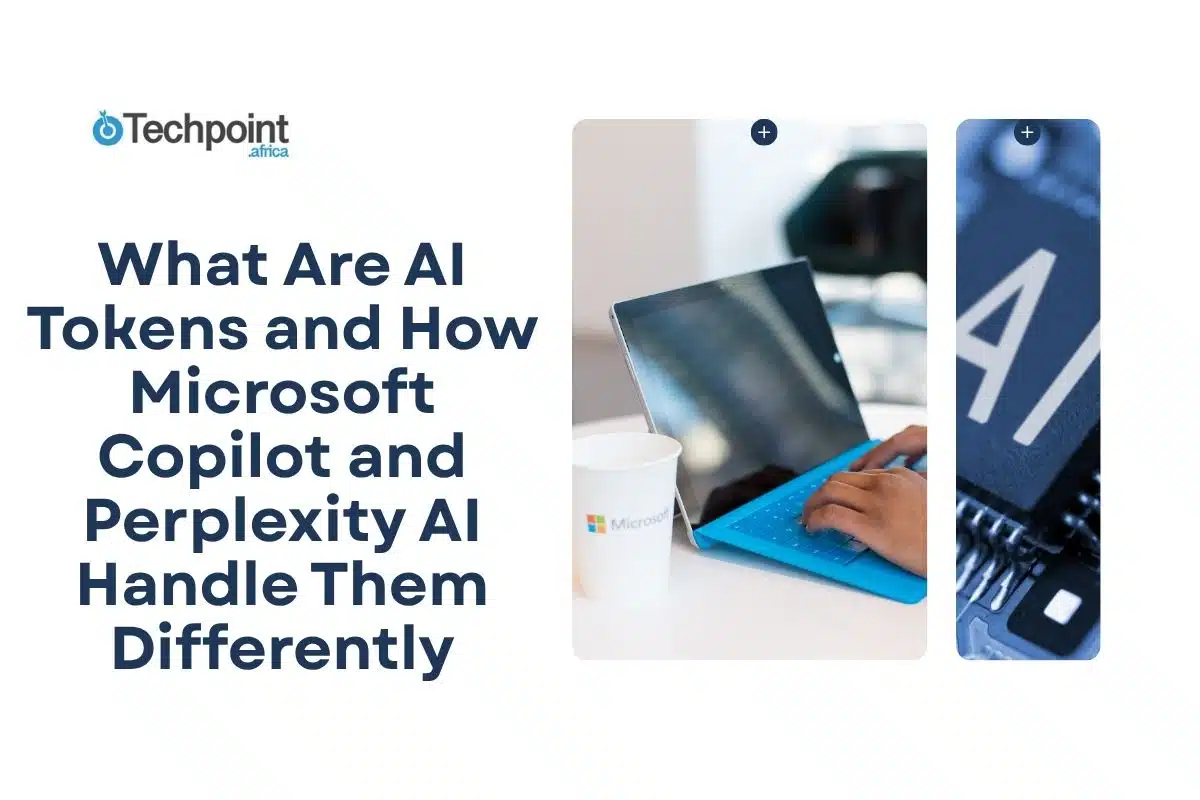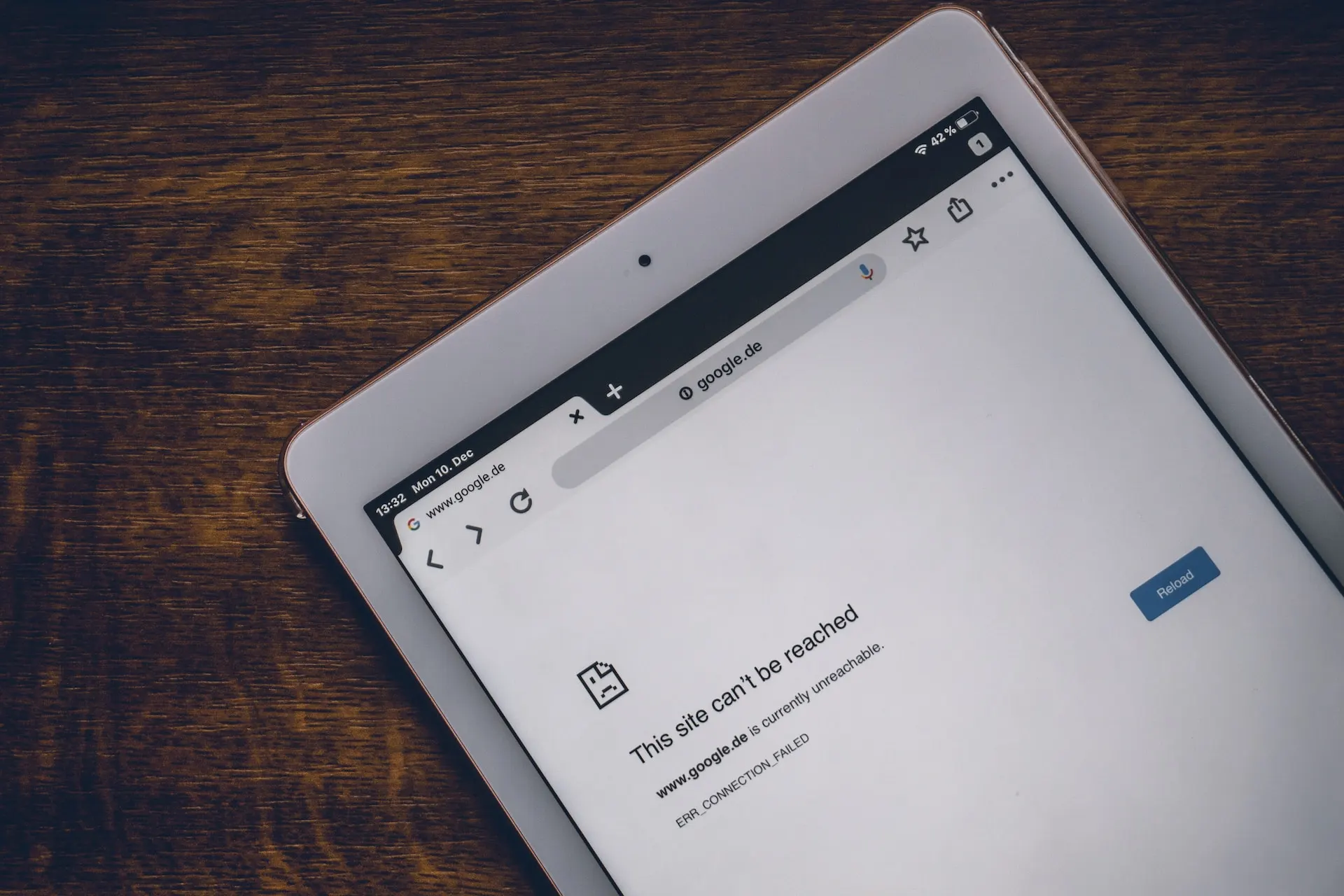
When you type a question or a command into an AI tool like Microsoft Copilot or Perplexity AI, the system doesn’t just process your entire sentence simultaneously like your friend would when you both text. Instead, it takes a different turn that takes so much behind-the-scenes work to break your input into understandable, smaller parts called tokens. These tokens can be several things, maybe whole words, parts of words, or even punctuation marks, but whatever it may be, these tokens are the basic pieces AI models use to understand your question and generate a meaningful response.
This article will richly explain AI tokens, why they matter, and how they are “watched” or monitored by AI systems. It will also compare how two leading AI tools—Microsoft Copilot and Perplexity AI—handle tokens to deliver their responses.
Let’s begin!
What Is a Token in AI?
A token is the smallest piece of information that an AI language model processes when it reads or generates text. Why does AI use tokens instead of whole sentences or paragraphs? Think of tokens as the building blocks of language AI uses to understand and communicate (more explanation below). It helps AI models analyze language in manageable pieces. When AI understands tokens and their order, it can learn patterns, meanings, and relationships between words, which helps it generate meaningful responses.
The Role of Tokens in AI-Language Models
Now that we understand what a token is and how much AI depends on tokens, the next question to clarify is : How do tokens actually work inside AI language models? To answer this, we need to explore the roles tokens play in helping AI understand and generate human language.
Tokens act as the Building Blocks of Language Understanding
Tokens act as AI models’ fundamental building blocks for processing language. Instead of reading entire sentences or paragraphs at once, AI breaks text down into sequences of tokens. Each token carries meaning—whether it’s a whole word, part of a word, or punctuation—and the order of these tokens helps the AI make sense of the text.
For example, consider the simple sentence:
- “The cat sat on the mat”
An AI model processes this sentence as a sequence of tokens: [“The“, “cat“, “sat“, “on“, “the”, “mat“]. The model recognizes that “cat” is a noun, “sat” is a verb, and the tokens form a meaningful sentence. By analyzing the tokens in order, the AI understands the relationships between words, which is crucial for generating coherent responses.
Also, aside from tokens being words chosen from a sentence, they can be punctuation marks, or even single characters. For example, the sentence:
- “AI is amazing!”
Might be split into tokens like:
[“AI“, “is“, “amazing“, “!“]
“!” becomes a token.
Lastly, sometimes, tokens are smaller parts of words, especially when words are long or uncommon. For instance, the word “unhappiness” can be broken down into:
[“un”, “happi”, “ness”]
In essence, tokens are the essential units that AI language models use to understand and generate text. By breaking language into tokens, AI models analyze sequences of meaningful units rather than raw text. This process of breaking text into tokens is called tokenization.
Different AI models use different tokenization methods.
Byte Pair Encoding (BPE): This method breaks words into subword units based on frequency, allowing the model to handle rare or new words by combining smaller parts.
WordPiece: Used by models like BERT, it splits words into subwords to efficiently represent language.
SentencePiece: Often used for languages without clear word boundaries, it treats text as a sequence of characters and learns token units from data.
This flexibility helps AI models understand and generate language more accurately. However, tokens are not limited to text (except for Natural Language Processing models). In other AI models, such as generative AI, tokens can represent small units of images or sounds.
Types of Tokens in Generative AI
Generative AI processes various types of tokens depending on the data it handles. Knowing these token types is key to grasping how AI models generate text, images, and audio.
Text Tokens
These are the most common tokens used in large language models (LLMs) such as ChatGPT. Text tokens include words, subwords, characters, and punctuation. For example, the word “unhappiness” might be split into “un” and “happiness.” Text tokens enable AI to generate human-like responses in chatbots, writing assistants, and code-generation tools.
Special Tokens
Special tokens serve specific roles within AI models. They mark the start or end of sequences, separate different input parts, or indicate unknown or padding elements. Examples include tokens like “[CLS]” (classification token) or “[SEP]” (separator token) used in models like BERT. These tokens help models understand structure and context beyond regular text.
Image Tokens
In models like DALL·E and Stable Diffusion, images are broken down into tokens representing patches or compressed visual features. For instance, DALL·E uses a variational autoencoder (VAE) to convert images into sequences of tokens that the model processes autoregressively. This tokenization allows AI to generate and manipulate images by predicting one token at a time.
Audio Tokens
Audio tokens represent sound segments in speech and voice models. Spoken language is converted into tokenized units, enabling AI to efficiently process and generate natural-sounding speech.
Each token type enables generative AI to handle different data modalities, making these models versatile across text, visual, and audio generation tasks.
Context Windows and Token Limits
AI language models have a limit on how many tokens they can process at once. This limit is known as the context window. For example, many models can handle around 4,096 tokens in a single input-output cycle. This means that the combined length of the user’s prompt plus the AI’s response cannot exceed this token count.
If the input text is too long, the model must truncate or ignore some tokens, usually from the beginning of the input. This truncation can cause the AI to lose important context, leading to less accurate or incomplete responses.
Because of this, managing token usage within the context window is critical for maintaining high-quality AI interactions. The context window limits how many tokens can be processed simultaneously, making token management important.
Attention Mechanisms: What Does It Mean to “Watch Tokens”?
Watching tokens refers to the various techniques and tools AI developers and systems use to track how many tokens are being processed at any given time. This involves counting tokens in both the input (the prompt or user query) and the output (the AI’s generated response) and analyzing which tokens the model focuses on internally.
By carefully monitoring tokens, AI systems can avoid exceeding their context window limits, prevent important information from being cut off, and ensure the generated responses remain relevant and coherent.
How AI Watches Tokens Internally
Modern AI models use attention mechanisms to “watch” tokens internally. Attention allows the model to focus on the most relevant tokens in the input when generating each output word.
For instance, if you ask a question about “renewable energy,” the model pays more attention to tokens related to “renewable” and “energy” in your input. This selective focus helps the AI generate an accurate and contextually appropriate answer.
Attention mechanisms enable the model to watch tokens carefully, focusing on the most relevant parts of the input to produce accurate and coherent responses. Attention mechanisms work by assigning tokens different weights based on their importance, enabling the model to capture complex relationships and nuances in language. In order for the attention mechanism to be at its A-game, monitoring token usage comes into play.
Why Is Monitoring Token Usage Important?
Here are why they are deemed essential:
Maintaining Context and Coherence
Since AI models have a maximum token limit per interaction, if the input plus output tokens exceed this limit, the model must truncate or ignore some tokens—usually from the beginning of the input. This can cause the AI to lose essential context, leading to incomplete or inaccurate responses. Watching tokens helps avoid this problem by managing the length and content of inputs and outputs.
Optimizing Performance
Processing more tokens requires more computational resources and time. By monitoring token usage, AI systems can optimize resource allocation, ensuring faster and more efficient responses.
Controlling Costs
Many AI platforms charge users based on the number of tokens processed. Watching tokens allows users and developers to manage usage effectively, reducing unnecessary token consumption and controlling expenses.
Techniques for Watching Tokens
Token Counters
These tools automatically count tokens in user inputs and AI outputs. They help users understand how much of their context window is used and how many tokens remain available for responses.
Attention Heatmaps
Visualizations that show which tokens the AI model focuses on during processing, such as attention heatmaps, help developers understand how the model “watches” tokens internally and which parts of the input are most influential in generating the output.
Caching and Grounding
Some AI systems cache tokenized data and use grounding techniques—providing the model with relevant background information—to reduce redundant token processing and improve efficiency.
In practical applications like chatbots, virtual assistants, or AI-powered writing tools, watching tokens is vital to maintaining smooth and meaningful interactions. For example, Microsoft Copilot monitors token usage to ensure that responses fit within the context window while providing detailed, accurate assistance across documents, spreadsheets, and emails.
By managing tokens effectively, Copilot balances the need for comprehensive answers with the constraints of token limits and computational costs.
Tracking Relationships Between Tokens
AI models don’t just look at tokens individually; they analyze how tokens relate to each other. This involves understanding grammar, syntax, and semantics—the rules and meanings that govern language.
By processing tokens sequentially and attending to relevant tokens, AI models learn patterns such as:
- Which words tend to appear together.
- How sentence structures form meaning.
- How context changes the meaning of words.
For example, the word “bank” can mean a financial institution or the side of a river. The AI uses surrounding tokens to determine which meaning applies in a given sentence.
Finally, by tracking relationships between tokens, AI models grasp the complexities of language, enabling them to communicate effectively.
How tokens are used in real-time AI tasks (inference and reasoning)
When an AI model generates a response or makes a prediction, it performs inference. During inference, tokens play a crucial role as the model processes the input tokens and produces output tokens step-by-step. Here’s how it gets done:
Processing Input Tokens
At the start of inference, the AI receives a prompt or query broken down into tokens through tokenization. These input tokens represent the user’s request in a form the AI can understand.
The AI model then analyzes this sequence of tokens, using its internal knowledge and training to interpret the meaning behind the prompt. This involves examining the relationships between tokens, identifying key concepts, and determining the context.
Generating Output Tokens
After understanding the input tokens, the model generates output tokens one at a time. Each new token is predicted based on the input and already generated tokens. This step-by-step generation continues until the model produces a complete and coherent response or reaches a token limit.
For example, when asked to write a short story, the AI predicts each word (token) by considering the previous tokens, ensuring the narrative flows logically.
Reasoning Through Tokens
Reasoning in AI involves making sense of complex information and drawing conclusions. Tokens are the pieces of information the model manipulates during this process.
The model “watches” tokens carefully, weighing their importance through attention mechanisms. It focuses on tokens that carry significant meaning or are crucial for answering the prompt accurately.
By iteratively processing tokens and updating its internal state, the AI can perform reasoning tasks such as answering questions, summarizing text, or solving problems.
Managing Token Flow
During inference, managing the flow of tokens is essential. The AI must balance providing detailed, informative responses with staying within token limits. Efficient token usage ensures that responses are complete without unnecessary verbosity.
So, tokens serve as both the input data and the building blocks of the AI’s output during AI inference and reasoning. The model processes input tokens to understand the prompt and then generates output tokens sequentially to form meaningful responses. Attention and token management ensure that the AI reasons effectively and produces coherent, relevant answers.
How tokens are used during the AI’s learning phase (training)
Before an AI model can perform inference, it must first be trained. During training, tokens are the fundamental units that the model learns from to understand language patterns, grammar, and meaning. Here are ways it gets achievable:
Feeding Tokens into the Model
Training begins with vast amounts of text data, which is tokenized into sequences of tokens. These token sequences repeatedly serve as the input that the model processes to learn language structures.
Each token in the training data provides information about how language works. The model analyzes millions or billions of such token sequences to identify patterns and relationships.
Predicting Tokens During Training
A common training objective is for the model to predict the next token in a sequence. For example, given the tokens:
“The cat sat on the”
The model learns to predict that the next token is likely “mat.”
The model gradually improves language understanding by repeatedly practicing this prediction task on massive datasets.
Adjusting Model Parameters
When the model’s predictions differ from the next token, it adjusts its internal parameters to reduce errors. This process, called backpropagation, uses token sequences to refine the model’s ability to predict and generate text accurately.
Learning Context and Semantics
Through training on token sequences, the model learns both word meanings and context, syntax, and semantics. This enables it to understand complex language constructs and generate coherent text during inference.
Handling Large Token Volumes
Training involves processing massive token datasets, often containing billions of tokens. Efficient tokenization and management are crucial to handle this scale without overwhelming computational resources.
Comparative Analysis: How Perplexity AI and Microsoft Copilot Handle Tokens and Interpret Natural Language Prompts
Artificial Intelligence tools like Perplexity AI and Microsoft Copilot have transformed how users access information and enhance productivity. While both utilize advanced language models, they differ significantly in tokenization approaches, context handling, and response styles. This analysis compares how these platforms process tokens and respond to natural language prompts, providing insights into their strengths and ideal use cases.
Introducing Perplexity AI and Microsoft Copilot
Perplexity AI is a user-friendly AI assistant designed for quick, concise answers with transparent citations. It uses standard subword tokenization optimized for rapid, clear responses, making it ideal for real-time research and fact-checking.
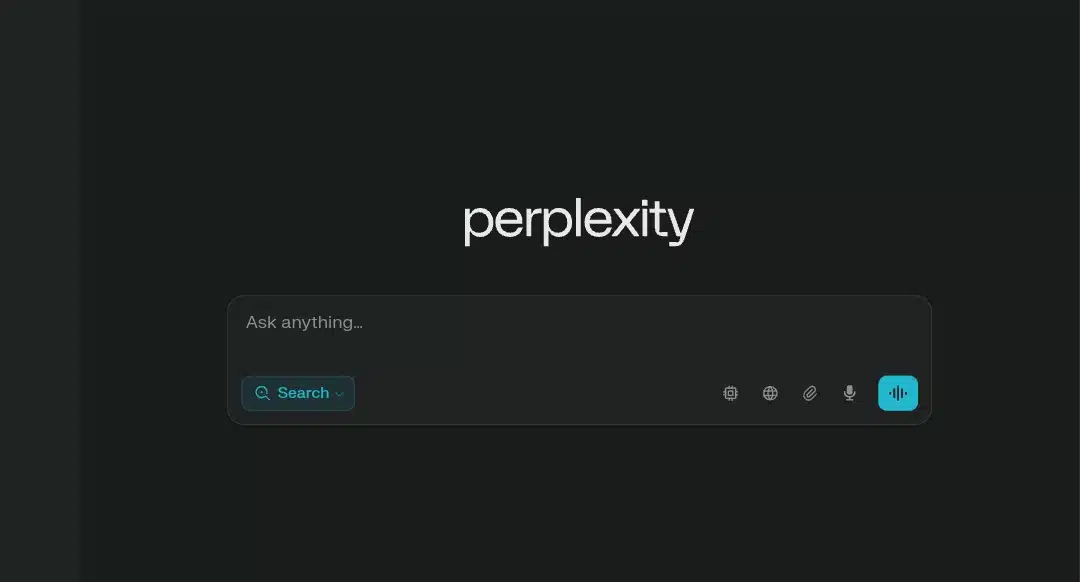
Microsoft Copilot is deeply integrated into Microsoft 365 apps, utilizing advanced Byte Pair Encoding (BPE) tokenization and token monitoring. It excels at handling complex, context-rich inputs and supports detailed document creation, data analysis, and workflow automation.
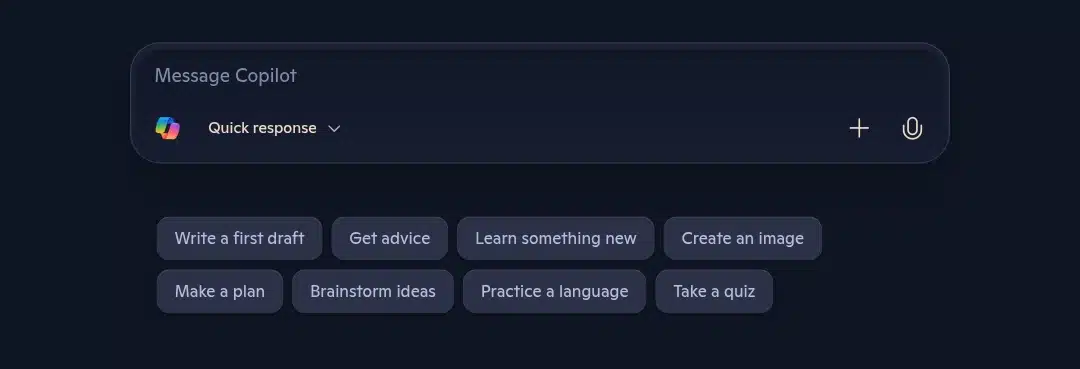
Tokenization Approaches and Context Windows
Microsoft Copilot: Uses BPE tokenization, which breaks words into subword units to efficiently handle rare or compound words. It supports large context windows (often 4,096 tokens or more), allowing it to process extended inputs and maintain context over longer conversations or documents.
Perplexity AI: Employs standard subword tokenization focusing on concise, relevant answers. Its context window is smaller than Copilot’s, optimized for brief queries and quick information retrieval.
Testing Natural Language Prompts on Both AIs
Below are four natural language prompts tested on both platforms. Each prompt includes a token breakdown, response comparison, and analysis.
Prompt 1: “Explain the benefits of renewable energy.”
Tokenization Breakdown
Microsoft Copilot:
- [“Explain“, “the“, “benefits“, “of“, “renewable“, “energy“, “.”] (7 tokens)
- 174 words, structured with bullet points and short paragraphs. Estimated token count: ~230–250 tokens.
Perplexity AI:
- Similar token breakdown with 7 tokens, processing each word as a token.
- 306 words, organized under subheadings with detailed explanations. Estimated token count: ~370–400 tokens.
Response Style and Content
Microsoft Copilot:
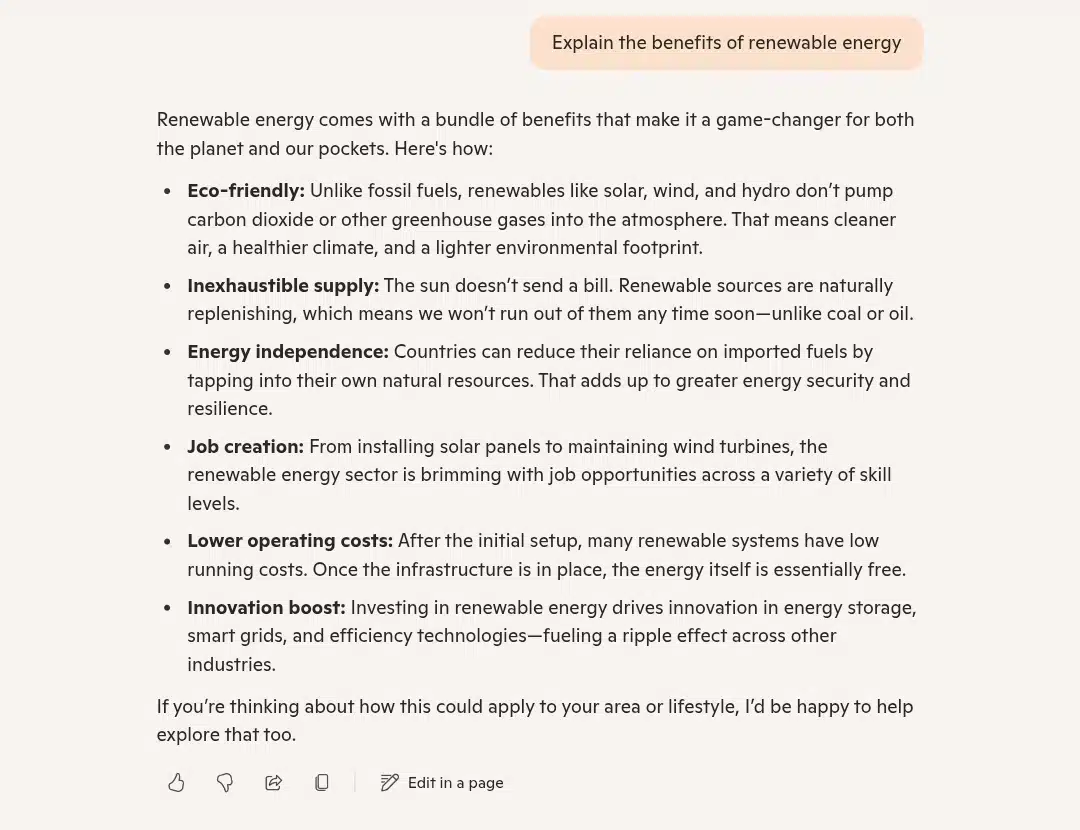
- Conversational and engaging, with clear bullet points covering environmental, economic, and social benefits. Ends with an offer to assist further.
Perplexity AI:
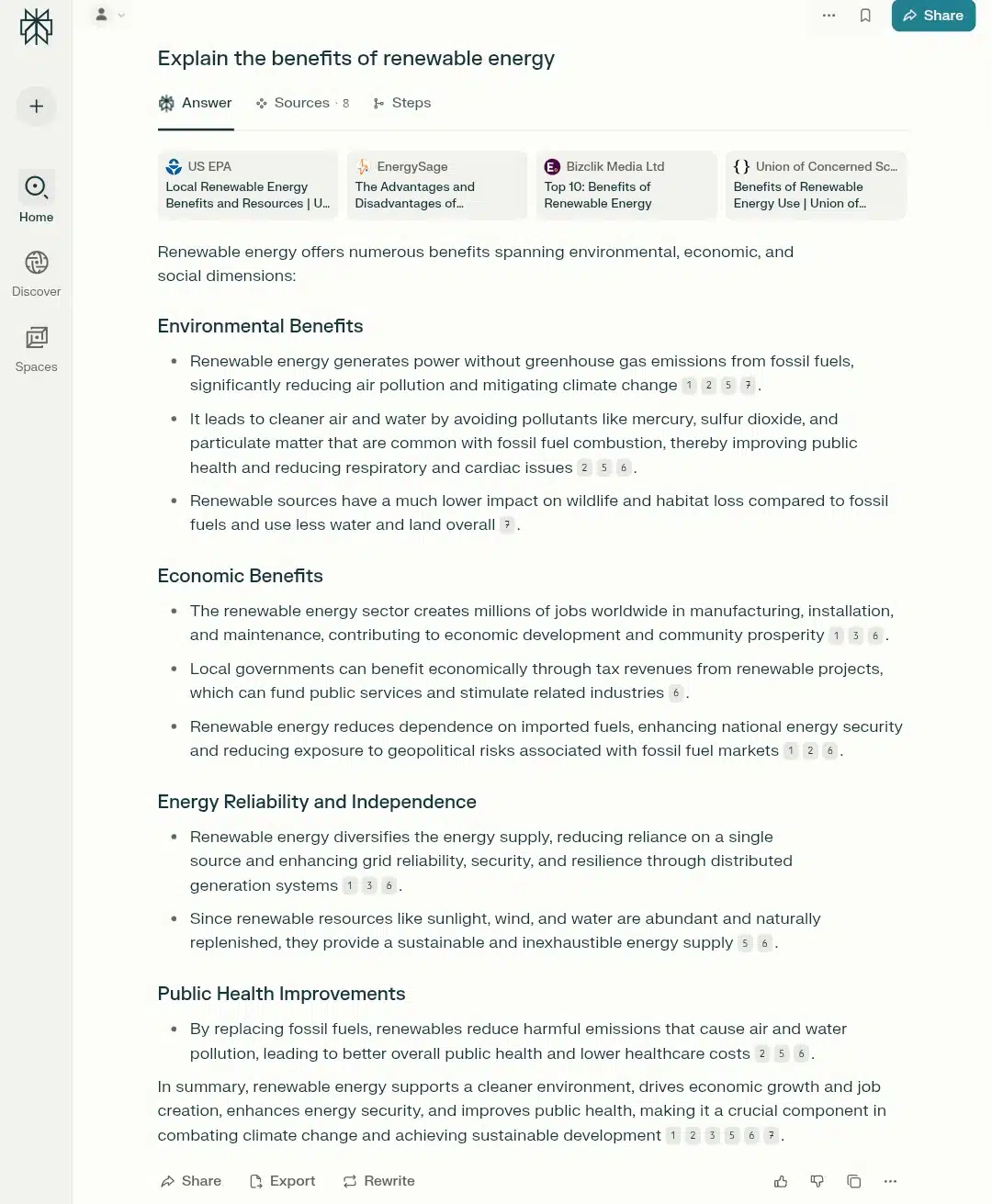
- Formal and structured, emphasizing key benefits with factual precision under clear categories.
Prompt 2: “What are the main causes of climate change?”
Tokenization Breakdown
Microsoft Copilot:
- [“What“, “are“, “the“, “main“, “causes“, “of“, “climate“, “change“, “?”] (9 tokens)
- 174 words, bullet-point style. Estimated tokens: ~230–250.
Perplexity AI:
- Also, 9 tokens, similarly segmented.
- 297 words, detailed paragraph format. Estimated tokens: ~360–390.
Response Style and Content
Microsoft Copilot:
- Concise bullet points highlighting major causes.
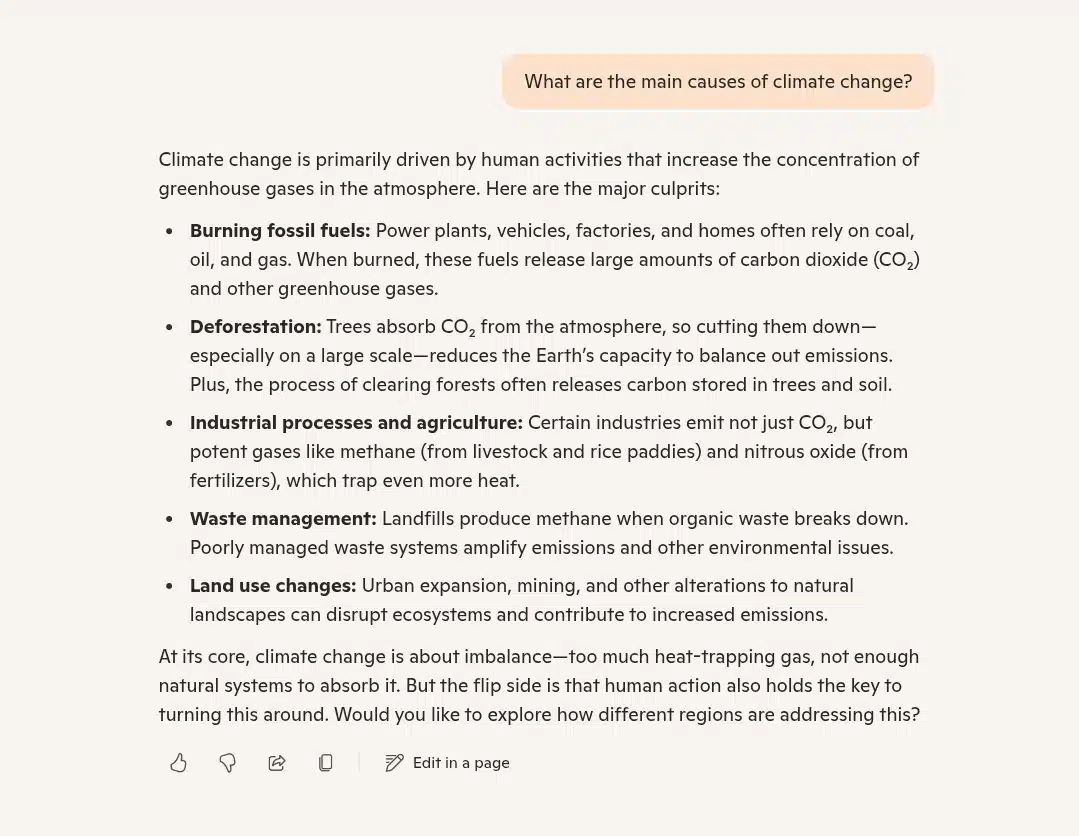
Perplexity AI:
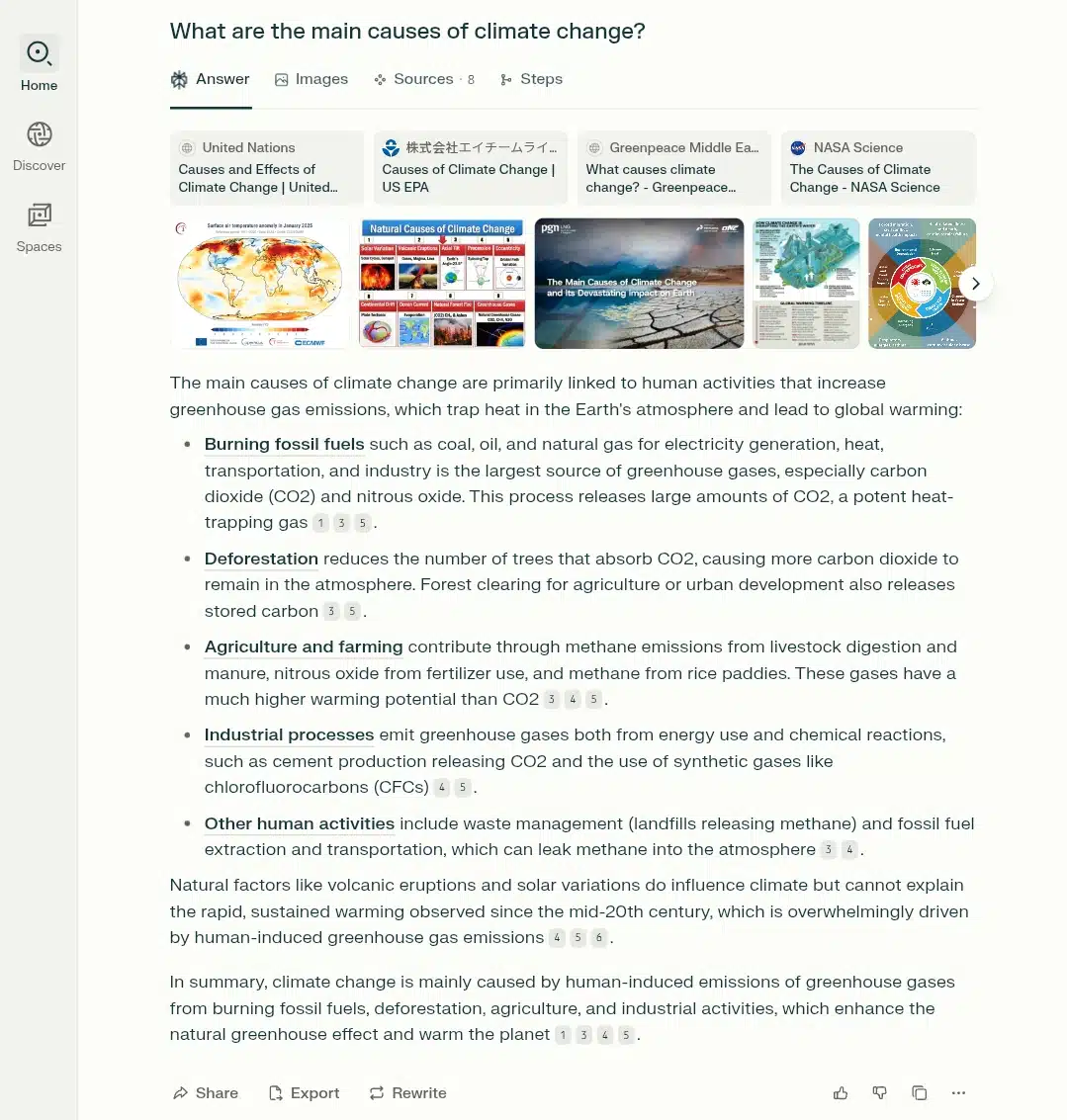
- A more comprehensive explanation including natural factors and human activities.
Prompt 3: “Summarize the key points of the Paris Agreement.”
Tokenization Breakdown
Microsoft Copilot:
- [“Summarize“, “the“, “key“, “points“, “of“, “the“, “Paris“, “Agreement“, “.”] (9 tokens)
- 195 words, bullet points with concise descriptions. Estimated tokens: ~260–280.
Perplexity AI:
- Exact token count and segmentation.
- 317 words, formal summary with detailed explanations. Estimated tokens: ~380–410.
Response Style and Content
Microsoft Copilot:
- Clear, accessible summary focusing on main goals.
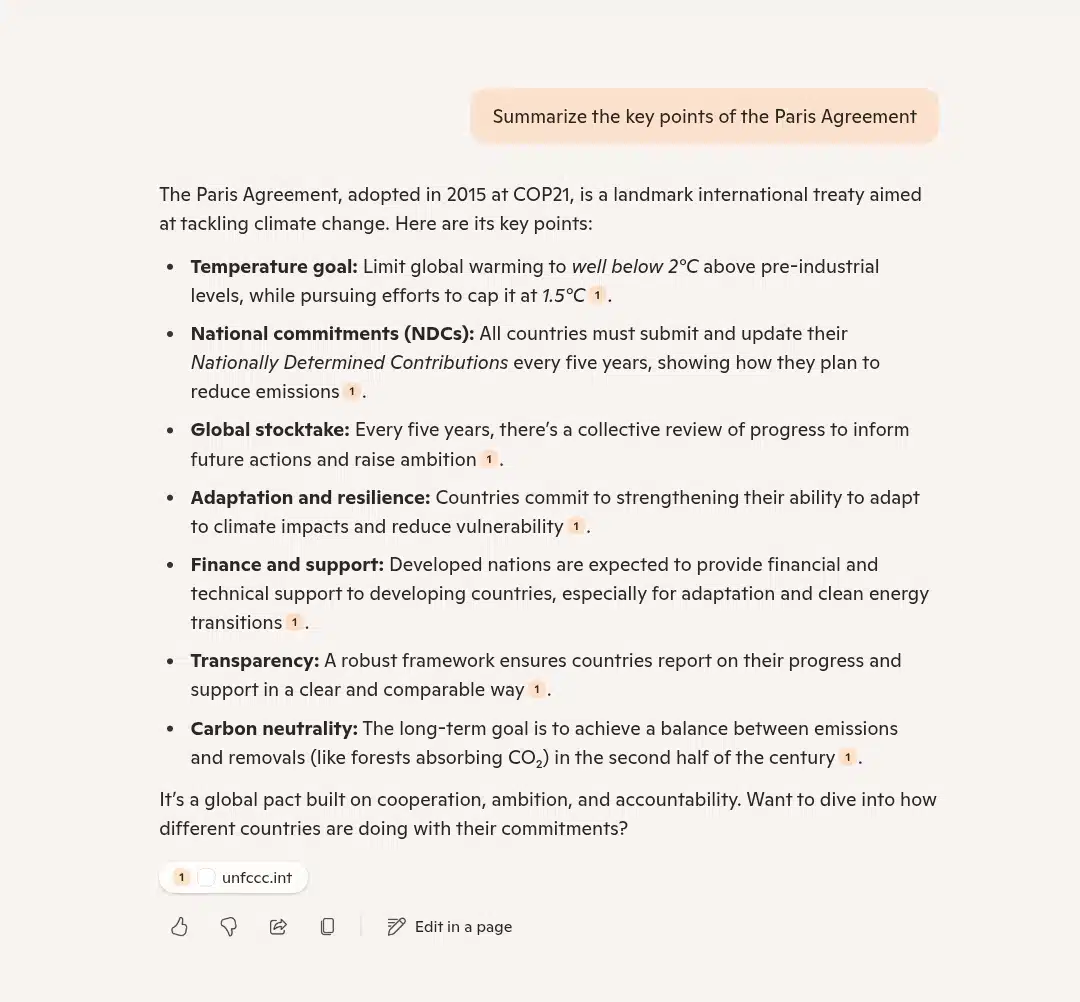
Perplexity AI:
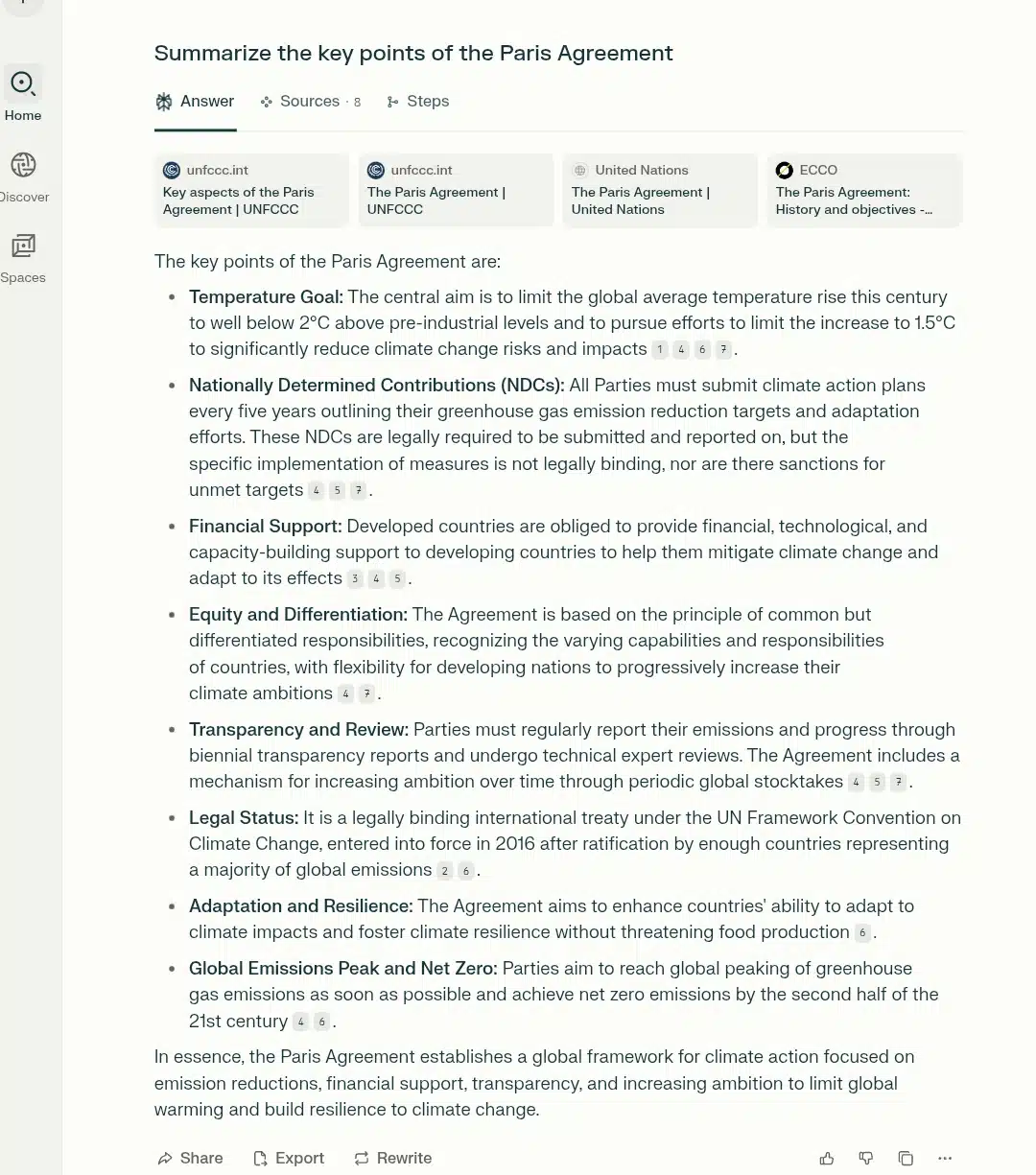
- Thorough, covering legal, financial, and equity aspects.
Prompt 4: “Suggest five healthy dinner recipes for vegetarians.”
Tokenization Breakdown
Microsoft Copilot:
[“Suggest“, “five“, “healthy“, “dinner“, “recipes“, “for“, “vegetarians“, “.”] (8 tokens)
- 144 words, descriptive bullet points with recipe details. Estimated tokens: ~340–370.
Perplexity AI:
Exact token count and breakdown.
- 132 words, concise recipe list with brief descriptions. Estimated tokens: ~230–250.
Response Style and Content
Microsoft Copilot:
- Rich, appetizing descriptions encouraging interaction.

Perplexity AI:

- Efficient, focused on essentials with nutritional highlights.
Microsoft Copilot and Perplexity AI tokenization summary
| Feature | Microsoft Copilot | Perplexity AI |
| Tokenization Method | Advanced Byte Pair Encoding (BPE) handles complex inputs and rare words | Standard subword tokenization, optimized for speed and efficiency |
| Context Window | Large (4,096+ tokens), supports extended and detailed inputs | Moderate context window, best for concise, focused queries |
| Response Detail | Engaging, conversational, bullet-point style with rich explanations | Formal, structured, concise summary-style answers with clear subheadings |
| Citation Transparency | Limited explicit citations; relies on internal or generalized knowledge | High transparency; often cites or references external sources |
| Integration | Deeply embedded in Microsoft 365 apps for productivity workflows | Web-based platform with API and Slack integrations |
| Best Use Cases | Enterprise productivity, document drafting, and detailed explanations | Real-time research, fact-checking, and quick Q&A sessions |
| User Interface | Integrated within familiar Microsoft productivity tools | Clean, minimalistic web interface focused on research |
| Cost Efficiency | Potentially higher token usage due to detailed, longer responses | Optimized for fewer tokens, making it more cost-effective for brief queries |
So,
- Microsoft Copilot produces shorter, engaging, conversational responses with bullet points and an inviting tone, ideal for users seeking quick yet friendly explanations.
- Perplexity AI offers longer, more formal, and structured answers with detailed subheadings and factual depth, suitable for users needing comprehensive and precise information.
- Both platforms effectively tokenize and process natural language prompts but differ in response length and style, reflecting their design priorities and target use cases.
Concluding,
Tokens are the basic units that AI models use to read and generate language. By breaking text into tokens, AI can analyze and understand complex sentences one piece at a time. How tokens are created and managed affects how much information an AI can handle at once and how well it keeps track of context.
Microsoft Copilot and Perplexity AI use different tokenization and token management approaches, affecting how they understand prompts and produce responses. By comparing these two tools, we see that each has strengths suited to different tasks.
Now that you know how tokens work, you’ll have a clearer picture of what happens behind the scenes when you interact with AI tools, helping you use them more effectively.

